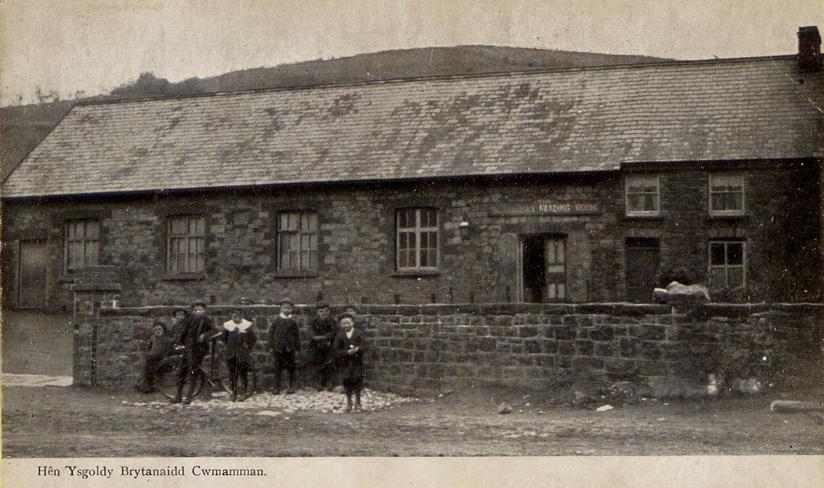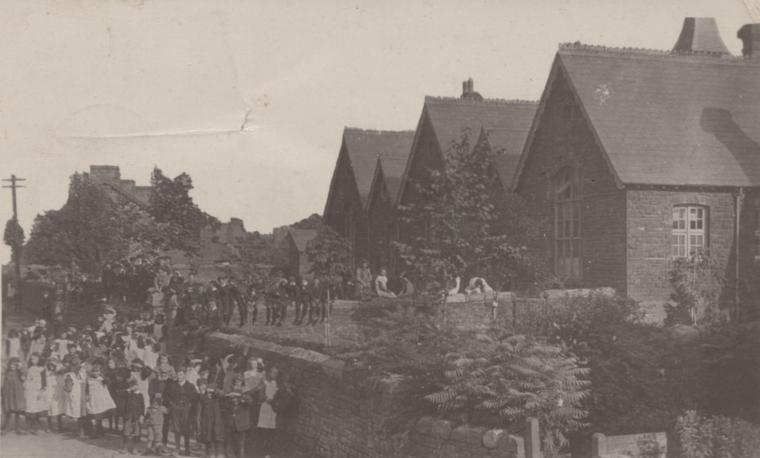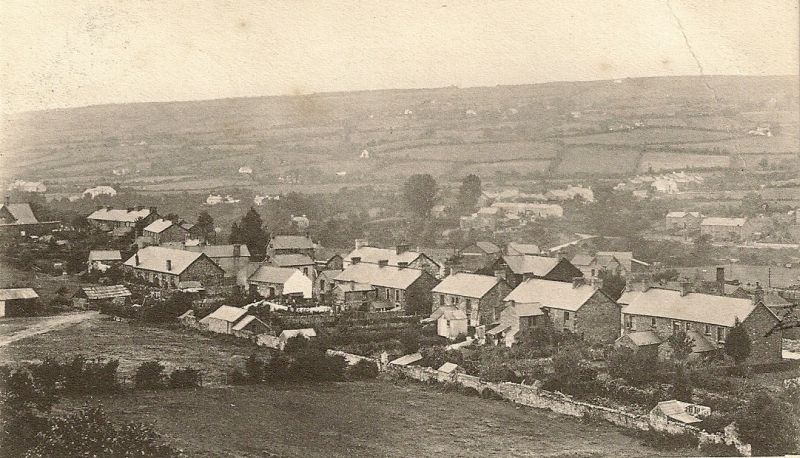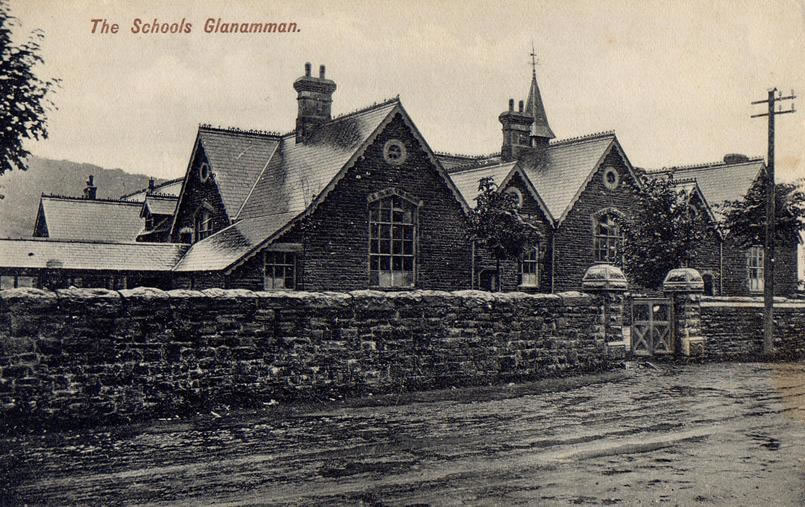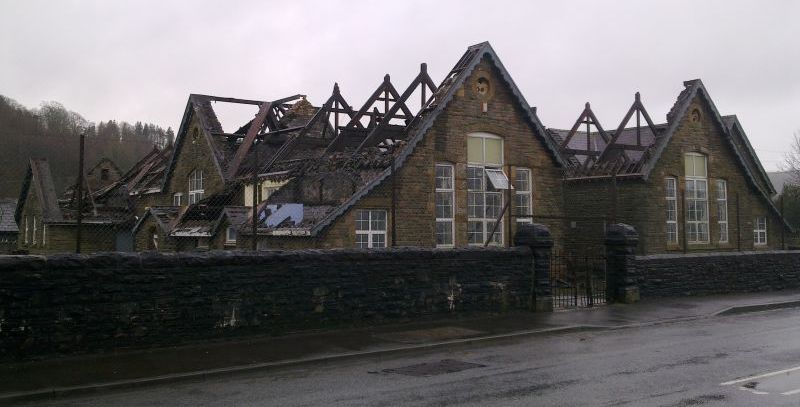Some Captured History of Glanamman and GarnantGlanamman Schools
Cwmamman British School, Glanamman; built in 1864 by members of the nonconformist population. Education of the children of Cwmamman, came about indirectly, through the influence of the Society for Promoting Christian Knowledge (S.P.C.K.), which was founded in 1698 and is still active today. The 25th September, 1708, saw the inauguration of Griffith Jones as a priest. Griffith Jones, from Pant-yr-Efel, Carmarthenshire, was educated at his local school before becoming a shepherd. He eventually furthered his education at Carmarthen Grammar School, before seeking ordination as a clergyman. He soon gained a reputation for drawing thousands of people from across Wales to hear him preach at the various Churches, Churchyards and sometimes mountains. This, however, did not endear him to his superiors and he was summoned to the Bishops Court at Carmarthen on several occasions for not adhering to Church laws and it's customs. As well as becoming a renowned clergyman, by 1709, Griffith Jones was also master of a S.P.C.K. school at Laugharne. After becoming a corresponding member of the Society for Promoting Christian Knowledge in 1713, he was appointed to the parish of Llanddowror in 1716. He was unsuccessful in persuading the S.P.C.K. in establishing a Welsh school in Llanddowror in 1731, the number of S.P.C.K. schools having fallen into decline in Carmarthenshire since 1713. This may have led Griffith Jones to setting up his Welsh Circulatiing Schools and although it is not certain when his schools first started, by 1737, there were 37 Welsh Circulating Schools, boasting 2,400 pupils. These schools ran for 3 months in each location. They ran through the winter months when demand for farm labour was at its lowest and frequently, it was various farmhouses that played host to the schools. The schoolmasters were trained at Llanddowror by Griffith Jones and these in turn taught the pupils of the various circulating schools to read the Welsh Bible and the basic principles of the Christian Church. Griffith Jones was also greatly influenced by Madam Bridget Bevan, a barristers wife, who, sometime between 1731 and 1737, became his chief patron and adviser. A connection between her and a family who lived at the grand Derwydd Mansion, Llandybie, resulted in Cwmamman becoming part of the scheme. Madam Bridget Bevan continued to promote the circulating schools after Griffith Jones died at her home in Laugharne in 1761. Madam Bevan herself died in 1779. Griffith Jones' annual publication; "Welsh Piety", listed farms in the locality which hosted the schools between 1741 and 1767.
There were also a number of Sunday Schools held in Cwmamman in the late 18th and early 19th century, such as the one held at Hên Bethel by the Morgan family of Brynlloi and the one hosted by Rhys Alexander at Ty'n Y Wern, (a farmhouse, between Jones Terrace and Glynmoch, Glanamman). Woodland Castle, on Tir Syr Walter in Garnant, also played host to a voluntary school, run by an ex colour-sergeant from Godre'r Graig cottage on Gelliceidrim Farm. Richard William and his wife built the house they named Woodland Castle in 1837 and here, their lessons were conducted in English. In 1923, John Anthony from Cwmamman was interviewed by the Amman Valley Chronicle and remembered that Richard William was a one legged old Crimean veteran who taught them spelling and sums. Richard William and his wife's lack of sympathy for their Welsh speaking pupils was demonstrated by their use of the "WELSH NOT", where anyone caught speaking their native tongue would have a piece of wood, bearing the letters "W.N." hung around their neck by a cord. If, during the day, the child heard another pupil speaking in Welsh, he would be allowed, and was probably eager, to pass on the wooden sign to the transgressor, as the person wearing the sign at the end of the day would receive punishment. The renowned hymn writer, poet and school master, Watcyn Wyn was once a pupil at Woodland Castle. By 1854 the Welsh circulating school movement had come to an end and the schools were absorbed into the system of the National Schools and British Schools. The National Schools were established in 1811 by the National Society for Church of England Schools, the founder being an Anglican clergyman named Andrew Bell. The British Schools were established in 1808 by the British and Foreign Schools Society for Nonconformist Schools, the founder being a Quaker named Joseph Lancaster. Lancaster and Bell both developed a style of education independently and simultaneously, known as the Monotorial system where a pupil would learn a subject and then in turn pass on the information to other pupils. Obvious benefits were that fewer schoolteachers were needed, therefore making it a cheaper system to operate. Joseph Lancaster's version of this was known as the Lancasterian System, which differed slightly from Bells system in that it preferred smaller class sizes. More information on this system can obtained from the Wikipedia website: http://en.wikipedia.org/wiki/Monitorial_system#The_Lancasterian_System The Cwmamman British School at Glanamman, opened on 2nd January, 1865 and the building continued to be used as a school until early January 1884. The construction work was carried out by David Hughes of Abergrenig, and later Bryngrenig, Glanamman. David Hughes with his wife Mary. The first headmaster of the school was William Edwards from Pembroke Dock, who would have been approximately 21 years old at the time. Nowadays it seems a great deal of responsibility for such a young man. The School Log illustrates the challenges that the school faced: lack of resources, not enough teachers or equipment, large class sizes and overcrowding. Periodically, the school suffered from poor attendance; especially at certain times of the year when labour was needed on the farms. William Edwards remained as headmaster of Cwmamman British School for nearly 10 years until he died in 1874, at the young age of 31. He is buried at Tabernacle Methodist Chapel, Glanamman. He was succeeded as headmaster of the school by his brother, David Edwards. William's son, J. T. Edwards, became the first headmaster of Garnant Council School, retiring in November 1933. Headstone of William Edwards at Tabernacle Methodist Chapel, Glanamman. In 1877, the Brynlloi School became an U. D. Board School; seven years after the Elementary Education Act of 1870, also known as Forsters Education Act, after the Liberal M.P. William Forster. The objective was that children could be given the opportunity of an elementary education from the age of 5 until they reached the age of 13. The 1880 Education Act made schooling compulsory for children from the age of 5 up to the age of 10. In February 1883, construction commenced on the new board school in Glanamman. The building work was carried out by Brown, Thomas and John of Llanelli, at a cost of £2,250, which in todays terms (as at 2007), would equate to approximately £126,090. The U. D. Board School transferred from the old Britannia School to the new building on 14th January, 1884. Although it should have been a day for celebration, the village being furnished with a brand new school; the event was overshadowed by the news of a terrible accident at Garnant Colliery. Six men and four boys died when the rope of the colliery cage broke and they plummeted to the bottom of the pit. This event occurred at 4 am and by the time the school opened, news of the accident had spread throughout the village. Glanamman School c.1900 The School Boards were abolished by the Education Act of 1902 and responsibility for the running of Glanamman School was taken over by the Council Education Committee. In 1909, the old Britannia School building at Glanamman Square was demolished and the site was used for the construction of Bryn Seion Chapel.
Glanamman Square view c.1909, showing both schools on left (moving the mouse over the school buildings will locate) At the Amman Valley Schools Managers Meeting in February 1914, the Education Committee intimated that several local schools including Glanamman, were to be lit by Gas and that all oil lamps should be returned. Following this, a local gentleman wrote an open letter to the Amman Valley Chronicle, stating that he had furnished the committee with a quotation for installing electric lighting. He stated that in his opinion, the committee, by opting for gas, had made the wrong decision.
The Amman Valley Chronicle reported that when the teachers of Carmarthenshire adopted a "Down Tools" policy on the 1st of May, 1918 over a pay dispute with the East Carmarthenshire Education Committee, local children were so delighted at their extra "holidays" that they paraded through the streets of Cwmamman singing all kinds of comic songs! The Local Education Authority proposal, for the closure of Glanamman and Garnant Primary Schools and the Twyn (also in Garnant), Infants School, was received by the Welsh Assembly Government on 17th May, 2002. The proposal then had to undergo an objection period, which closed on 17th July, 2002, with no objections formally received. The proposal then received L.E.A. approval and implementation. An open day for former staff and pupils of Glanamman School took place on 26th February, 2005: 121 years and 12 days after the school first opened. A new state of the art school opened at the site of the old Twyn School in Garnant, after Whitsun, 2005. The official opening ceremony took place on 8th December, 2005 and was attended by the First Minister of the Welsh Assembly, Rhodri Morgan. The Welsh medium school closed in 2005 and planning permission was approved on 9th November, 2006, for a private developer to convert the building into three dwellings. The minutes from the Govenors' / Managers' meetings from 1973 to 1988 are kept at the Carmarthenshire Archives Office at Carmarthen, as well as the log books for Glanamman School. Glanamman School from Brynlloi Road, October 2007.
Glanamman School being demolished, March 2014 Thanks to Dilys E. Jenkins who allowed me to use information from
her document entitled; "Llandeilo Bridge and it's Cwmamman Connections",
created in 1996, for the Amman Valley Historical Society. Other sources
of information include the Amman Valley Chronicle; "Hanes Ysgol
Glanaman", by Huw Walters; "Hanes Ysgol Y Garnant",
by Olwen Richards; "Haner Canrif o Hanes Bryn Seion, Glanaman",
by John Jenkyn Morgan; The South Wales Guardian website and an online
document produced by Dr Mary Clement, Ph.D., for the National Library
of Wales. Her document can be accessed by clicking on the following
link: |
